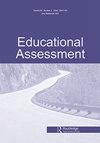纵向社会情绪调查问卷测量方法的比较
IF 2.3
Q1 EDUCATION & EDUCATIONAL RESEARCH
引用次数: 0
摘要
摘要:我们对儿童如何发展的了解大多基于调查数据。为了估计随时间的增长,从而更好地了解发展,通常会在重复的时间点进行短期调查。在估计增长之前,必须将这些重复的衡量标准放在相同的尺度上。然而,很少有研究考察规模决策如何影响从调查项目回复中得出的增长比较。在这项研究中,我们使用了174669名7至12年级的学生作为样本,他们在四年内进行了同样的自我效能感和社会意识调查。我们使用这些调查项目的回答,使用不同的方法构建量表,然后比较所得的分数,看看关于青春期随时间变化的推断如何根据量表而变化。虽然我们发现,通过缩放方法得出的关于平均趋势的结论是非常一致的,但通过缩放方法对类似变化的效应大小的具体量化可能会有所不同。本文章由计算机程序翻译,如有差异,请以英文原文为准。
A Comparison of Methodologies for Scaling Longitudinal Social-Emotional Survey Responses
ABSTRACT Much of what we know about how children develop is based on survey data. In order to estimate growth across time and, thereby, better understand that development, short survey scales are typically administered at repeated timepoints. Before estimating growth, those repeated measures must be put onto the same scale. Yet, little research examines how scaling decisions affect comparisons of growth derived from survey item responses. In this study, we use a sample of 174,669 students in grades 7 through 12 who took the same self-efficacy and social awareness surveys for four years. We use those survey item responses to construct scales using different approaches, then compare the resultant scores to see how inferences about changes over time during adolescence might shift dependent on scaling. While we find that conclusions about average trends are quite consistent by scaling approach, specific quantifications of change like effect sizes can differ by scaling method.
求助全文
通过发布文献求助,成功后即可免费获取论文全文。
去求助
来源期刊

Educational Assessment
EDUCATION & EDUCATIONAL RESEARCH-
CiteScore
3.20
自引率
6.70%
发文量
24
期刊介绍:
Educational Assessment publishes original research and scholarship on the assessment of individuals, groups, and programs in educational settings. It includes theory, methodological approaches and empirical research in the appraisal of the learning and achievement of students and teachers, young children and adults, and novices and experts. The journal reports on current large-scale testing practices, discusses alternative approaches, presents scholarship on classroom assessment practices and includes assessment topics debated at the national level. It welcomes both conceptual and empirical pieces and encourages articles that provide a strong bridge between theory and/or empirical research and the implications for educational policy and/or practice.
 求助内容:
求助内容: 应助结果提醒方式:
应助结果提醒方式:


